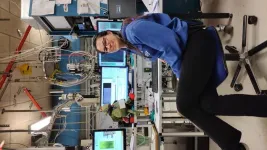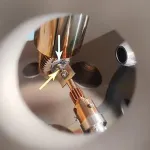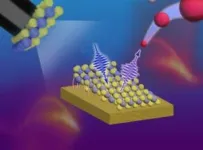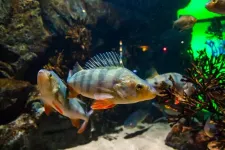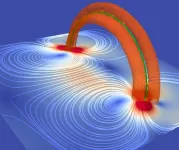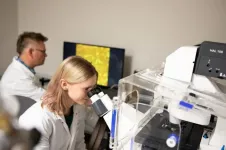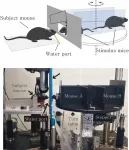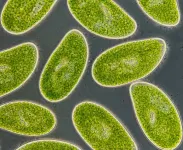(Press-News.org) Ever since the discovery of the two-dimensional form of graphite (called graphene) almost twenty years ago, interest in 2D materials with their special physical properties has skyrocketed. Famously, graphene was produced by exfoliating bulk graphite using sticky tape. Although it was good enough for a Nobel Prize, this method has its drawbacks. An international team of surface scientists has now developed a simple method to produce large and very clean 2D samples from a range of materials using three different substrates. Their method, kinetic in situ single-layer synthesis (KISS) was described in the journal Advanced Science on 1 June.
2D materials have physical properties that are not shared by bulk material. The confinement of charge carriers is one reason for this. There are two ways to produce these 2D materials: exfoliating a larger crystal or growing a 2D layer. Exfoliation means peeling off layers from a larger crystal until you are left with just one layer. ‘This process is time-consuming and requires specific skills and equipment,’ says Antonija Grubišić-Čabo, a surface scientist at the University of Groningen (the Netherlands) and first author of the Advanced Science paper. ‘Furthermore, it often results in very small flakes, while the adhesive tape that is used can leave polymers on their surfaces.’
Gold
Growing 2D films is another approach. This allows the production of large samples under controlled conditions. ‘However, it often takes a lot of time to work out how to grow such 2D materials. And the process doesn’t always result in a perfect layer,’ says Grubišić-Čabo. Together with last author Maciej Dendzik, she assembled a ‘dream team’ of colleagues, many of whom had previously worked together at Aarhus University (Denmark) as PhD students, to develop a simple technique for the production of 2D materials.
‘We knew of some experiments in which gold films were used to exfoliate bulk material. But these were mainly performed in air which means that this technique is not very suitable for air-sensitive materials, or for surface science research.’ The team wanted a technique that would allow the production of air-sensitive 2D materials on a range of substrates. In their first attempt, they used a gold crystal in a high vacuum chamber. ‘We basically slammed the crystal on bulk material and discovered that a nice 2D layer stuck to the gold.’ Why this happens is not yet clear, but the team suspects that the bond with the gold is stronger than the Van der Waals force that keeps the layers in the bulk crystal together.
Devices
They have built on this first experiment, adding a spring to the stage with the bulk material which acts as a shock absorber and thus allows better control of the impact of the gold crystal. Furthermore, the team showed that both silver and the semiconductor germanium could be used as a substrate to peel off 2D materials. ‘Gold crystals are a standard feature in surface science labs, where they are used in the calibration of instruments, for example. Scientists don’t like to damage these crystals, but that didn’t happen in these experiments,’ says Grubišić-Čabo. ‘And we have since changed the protocol to use single crystal gold thin films. This has the added advantage of being able to dissolve the gold so that we can isolate the 2D sample, as long as it is stable in air or liquid.’
These isolated samples may be used for the next stage: building devices from the 2D materials that will be produced using the KISS technique. ‘This is not yet possible, but we are working on it,’ says Grubišić-Čabo. ‘So, what we do have is a technique to produce very clean, large 2D samples in a very simple way, which allows us to create air-sensitive 2D materials. Furthermore, our technique uses standard equipment that is present in virtually every surface science laboratory.’
Reference: Antonija Grubišić-Čabo, Matteo Michiardi, Charlotte E. Sanders, Marco Bianchi, Davide Curcio, Dibya Phuyal, Magnus H. Berntsen, Qinda Guo, Maciej Dendzik: In situ exfoliation method of large-area 2D materials. Advanced Science, 1 June 2023.
END
Producing large, clean 2D materials made easy: just KISS
2023-06-01
ELSE PRESS RELEASES FROM THIS DATE:
House of moveable wooden walls unveiled, promising a cheaper, greener alternative to ‘knocking through’.
2023-06-01
University of Cambridge architects are inviting visitors to the London Design Biennale to experience a prototype home constructed with flexible wooden partition walls which can be shifted to meet the changing needs of residents. The invention aims to reduce waste and carbon while also improving living conditions for those who cannot afford expensive refurbishments.
[Images will be available to download here from 10AM (UK Time) on 1st June]
House-owners the world over consider ‘knocking through’ walls to achieve more open-plan living or changing layouts to accommodate new arrivals or circumstances. ...
Biodegradable plastic from sugar cane also threatens the environment
2023-06-01
Plastic made from cane sugar also threatens the environment. Researchers from the University of Gothenburg have found that perch change their behaviour when exposed to so-called bioplastic.
Traditional plastic, based on fossil oil, has flooded the earth and there is microplastic in all living things. This has led to intensive research for alternatives that decompose faster in nature. Bio-based polymers based on cane sugar are one such option. The most common bioplastic is poly-L-lactide (PLA), which is used in 3D printers, textiles, food packaging, disposable cutlery and other applications.
PLA plastic changed the behaviour of perch
Bioplastics also have a negative impact on biological ...
Finally solved! The great mystery of quantized vortex motion
2023-06-01
Liquid helium-4, which is in a superfluid state at cryogenic temperatures close to absolute zero (-273°C), has a special vortex called a quantized vortex that originates from quantum mechanical effects. When the temperature is relatively high, the normal fluid exists simultaneously in the superfluid helium, and when the quantized vortex is in motion, mutual friction occurs between it and the normal-fluid. However, it is difficult to explain precisely how a quantized vortex interacts with a normal-fluid in motion. Although several theoretical models have been proposed, it has not been clear which model is correct.
A research group led by Professor Makoto Tsubota and Specially ...
Q&A: Virginia Tech researchers discover new, more effective candidates for treatment of syphilis
2023-06-01
Since 2000, sexually transmitted infection rates have been on the rise. Syphilis, a disease that was nearly eradicated in the United States at that time, now affects more than 18 million people worldwide each year with few options for effective treatment.
One challenge that has plagued syphilis researchers for decades was the inability to culture and study the disease-causing agent in a laboratory setting.
“The incredible efforts of our colleagues and collaborators produced a faithful system to propagate the disease-causing agent in vitro, or in a laboratory setting. Being able to culture ...
Discovery of neurons that recognize others
2023-06-01
Researchers from the Center for Cognition and Sociality (CCS) within the Institute for Basic Science (IBS) recently announced the discovery of neurons that allow us to recognize others. The research team discovered that the neurons that deal with the information associated with different individuals are located in the CA1 region of the hippocampus.
Social animals, including humans, constantly engage in interactions with others. In this process, the ability to recognize the identity of the social counterpart, retrieve relevant information about them from memory, ...
Little-known microbes could help predict climate tipping points
2023-06-01
DURHAM, N.C. -- Researchers studying a group of widespread but often overlooked microbes have identified a climate feedback loop that could accelerate climate change. But it’s not all bad news: this one comes with an early warning signal.
Using a computer simulation, a team of scientists from Duke University and the University of California, Santa Barbara, showed that most of the world’s ocean plankton and many other single-celled creatures in lakes, peatlands and other ecosystems could cross a threshold where instead of soaking up carbon dioxide, they start doing the opposite. That’s because of how warming affects their metabolism.
Because carbon dioxide ...
Makers of PFAS ‘forever chemicals’ covered up the dangers
2023-06-01
The chemical industry took a page out of the tobacco playbook when they discovered and suppressed their knowledge of health harms caused by exposure to PFAS (per- and polyfluoroalkyl substances), according to an analysis of previously secret industry documents by UC San Francisco (UCSF) researchers.
A new paper published May 31, 2023, in Annals of Global Health, examines documents from DuPont and 3M, the largest manufacturers of PFAS, and analyzes the tactics industry used to delay public awareness of PFAS toxicity and, in turn, delay regulations governing their use. PFAS are widely used chemicals in clothing, ...
Antipsychotic drugs use increased in Canadian long-term care homes in first year of pandemic
2023-06-01
While most aspects of care quality in long-term care homes did not differ in the first year of the pandemic from pre-pandemic levels, a new study shows that the use of antipsychotic drugs increased in all provinces.
The study analyzed health system performance reports provided by the Canadian Institute for Health Information (CIHI) over three years: two before the pandemic and the first year of COVID-19. The reports are based on more than half a million resident assessments completed in Ontario, Manitoba, Alberta and British Columbia.
Researchers ...
Northsiders are more connected to nature than southsiders: study
2023-06-01
New research into Melburnians’ connection to nature is helping the City of Melbourne understand how to engage its community members in conservation efforts.
The study, led by RMIT University in collaboration with the City of Melbourne and Queensland University of Technology, surveyed over 1,500 City of Melbourne residents and visitors on their connection to nature and found nearly 75% of respondents had a high connection to nature.
More than 75% of respondents said they were concerned about climate change and the destruction of nature.
However, retirees and university students who have lived most of their lives in the Melbourne ...
Preventing truck crashes needs to take ‘dashcam’ approach to driver ‘microsleeps’
2023-06-01
Researchers using dashcam footage of real-world collisions involving large trucks to analyze driver and vehicle behavior has found that anti-drowsiness alarms or similar technologies to prevent falling asleep at the wheel need to go beyond a focus on monitoring the drivers’ eyes, and consider other microsleep behaviors including a relaxation of back and neck muscles and abnormal activity of the vehicle itself.
A study reporting the researchers’ findings was published April 13 in the ...
